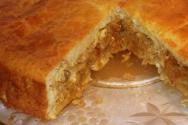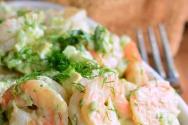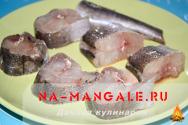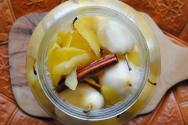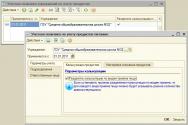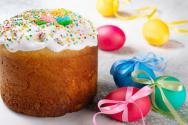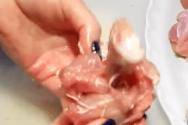Presentation on semi-finished biscuit dough. Biscuit dough. Sponge cake with apples
Lesson topic:
Preparation of biscuit dough and products made from it
Compiled by master
industrial training
Larina Galina Anatolyevna

Lesson objectives:
Formation of knowledge about the features and methods of preparing biscuit dough, methods of molding, baking products from this dough.






Main raw materials
essence
I eggs
Flour
Sugar pesso To
Starch

Additional raw materials
- cocoa,
- coffee,
- nuts,
- vegetables,
- oil

Combine eggs with granulated sugar and, stirring, heat in a water bath to 45 O WITH

Beat the egg-sugar mixture until its volume increases 2.5-3 times and until a stable pattern appears on the surface, cool to 20 O WITH

The flour is combined with starch and quickly (but not abruptly) mixed with the egg-sugar mass. At the end of the kneading, add essence.

The finished biscuit dough is baked in capsules, on baking sheets or molds at t 200-210 O From 10-30 minutes depending on the form used .



Quality indicators
- Appearance
- Color
- Consistency
- Taste

Quality requirements :
- Appearance:
a) shape– saved, correct;
b) surface - smooth
in colour crust - light brown, crumb - yellow
d) consistency- lush, porous;
- Taste - sweetish;
- Humidity– 25 ±3%


Technological dictation (Execution time – 7 minutes)
Statement
Answer
"Yes or no"
To improve the taste, vanillin is added to the biscuit dough.

Standard answers
Statement
Answer
The sponge dough is loosened chemically.
"Yes or no"
Biscuit dough can only be prepared in a warm way.
Biscuit dough requires the use of baking pans.
As the baking temperature increases, “hardening” will occur.
If, after pressing with your finger, a depression remains on the surface of the sponge cake, then the sponge cake is baked.
To strengthen the structure, the biscuit must mature.
Biscuit baking temperature 240 – 260˚С
To improve the taste, essence is added to the biscuit dough.
The semi-finished sponge product is used only for making cakes.
The biscuit has a fluffy, light structure, so it is very easy to process.

Evaluation criterion
Each correct answer - 1 point

Criteria for evaluation
Grade
Number of points

Control card
- Full name of the student gr. 915PKf………………………………………………..
EXERCISE
Test
AMOUNT OF POINTS
Message on topic
Lesson work - answers to questions
Technological dictation
TOTAL
Lesson grade

Reflective test
I know and I will explain it to someone else
I doubt I know

Homework:
Draw up a technological scheme for preparing a biscuit semi-finished product.
Add slides to the section for each topic, including slides with tables, charts, and images.
For sample table, chart, image, and video layouts, see the next section.

Thank you
Description of the presentation by individual slides:
1 slide
Slide description:
Lesson topic: “Sponge dough and products made from it” Prepared by teacher of special disciplines: Mazur N.G.
2 slide

Slide description:
The biscuit has a light and fluffy structure and is easy to process. To prepare the sponge cake, use flour with a small gluten content, otherwise it will turn out to be too long and have poor rise. The biscuit is prepared by beating, during which a large amount of air is introduced into the mass, and the dough greatly increases in volume. Thanks to its fluffiness and elasticity, a variety of pastries and cakes are prepared from sponge cakes. Depending on the cooking method and recipe, the main (heated) and round (boucher, cold) sponge cakes are prepared. The biscuit is also prepared with various fillings (cocoa, nuts, butter, vegetables).
3 slide

Slide description:
Technological scheme for preparing biscuit semi-finished product (main) and products made from it
4 slide

Slide description:
25% of flour can be replaced with starch to reduce the amount of gluten. In addition, thanks to starch, the biscuit turns out drier, the products have even pores and do not crumble so much when cutting. Preparing a sponge cake consists of the following operations: combining eggs with sugar, heating and beating them, mixing the egg-sugar mass with flour. Combine the eggs with granulated sugar and, stirring, heat in a water bath to 45*C. At the same time, the yolk fat melts faster and has a more stable structure. Main biscuit (heated)
5 slide

Slide description:
Beat the egg-sugar mixture until the volume increases by 2.5-3 times and until a stable pattern appears on the surface (the trace does not flow when passed over the surface). During whipping, the mass is cooled to 20°C. The flour is combined with starch and quickly (but not abruptly) with the beaten egg-sugar mass so that the dough does not tighten and settle. If kneading is done in a beater, it should last no more than 15 seconds. It is recommended to use vanilla or rum essence. Add it at the end of beating the egg-sugar mass.
6 slide

Slide description:
The finished biscuit dough is immediately baked in capsules, cake tins and on sheets, as it settles during storage. Capsules, forms and sheets are lined with paper, but you can also grease them with margarine or confectionery fat. The biscuit dough is placed in molds at )/4 of their height, since during baking it increases in volume and can leak out. Biscuit dough is baked on sheets for rolls and some types of pastries and cakes. The dough is poured onto a sheet lined with paper in a layer of no more than 10 mm and leveled with a knife. The biscuit dough is baked at a temperature of 200-210°C. Baking time depends on the volume and thickness of the dough. So, biscuits are baked in capsules for 50-60 minutes, in cake tins for 35-40 minutes, on sheets for 10-15 minutes. In the first 10 minutes, the semi-finished biscuit product should not be touched, as the shock will cause it to settle (the fragile walls of the air bubbles will burst).
7 slide

Slide description:
The end of the baking process is determined by the light brown color of the crust and elasticity. If, when pressed with a finger, the hole quickly recovers, the biscuit is ready. During baking at high temperatures, a dark, thickened crust is formed, and at low temperatures, the biscuit semi-finished product has a pale crust. If the baking time is insufficient, compacted areas of the crumb (“hardening”) will form.
8 slide

Slide description:
The baked semi-finished biscuit product is cooled for 20-30 minutes. Then they are freed from capsules and molds, cutting with a thin knife along the entire perimeter of the sides and dumping the semi-finished biscuit product onto the table. If the biscuit is subsequently used to prepare products that are soaked in syrup, then the paper is not removed and left for 8-10 hours to strengthen the structure of the crumb. The paper protects the biscuit from drying out too much. The biscuit should be kept at a temperature of about 20*C. After this, the paper is removed, the biscuit semi-finished product is cleaned and cut horizontally into two layers. In this form, the semi-finished biscuit product is used to make pastries and cakes.
Slide 9

Slide description:
the biscuit semi-finished product should have a light brown, smooth, thin top crust; lush porous elastic structure; yellow color of the crumb. Humidity (25 ± 3)%. Quality requirements
10 slide

Slide description:
Types of defects Causes of occurrence Semi-finished biscuit product is dense, small in volume, low-porous Flour with a high gluten content (without added starch); eggs are not beaten enough; long kneading with flour; the dough was not baked for a long time; mechanical stress during baking; increased amount of flour The semi-finished sponge product has compacted areas of the crumb (“hardening”) Insufficient baking time The semi-finished sponge product has lumps of flour Insufficient space; all the flour was poured in at once. The biscuit semi-finished product has a pale crust. Low baking temperature; insufficient baking time The biscuit semi-finished product has a burnt or dark brown thickened crust High baking temperature; long baking time
11 slide

Slide description:
For this biscuit, use only fresh or diet eggs, in which the yolk is well separated from the white. The dough is made more viscous and thick. No starch is added to it. Preparation consists of the following operations: whisking separately the whites and yolks with sugar, combining the whipped yolks, whites and flour. Egg yolks are combined with granulated sugar according to the recipe and beaten until the volume increases by 2.5-3 times. At the same time, beat the egg whites until the volume increases S-6 times and until a stable foam (does not drip from the whisk) slowly at first, then gradually the pace of beating increases; At the end, citric acid is added to strengthen the protein structure. Round sponge cake (boucher)
To use presentation previews, create a Google account and log in to it: https://accounts.google.com
Slide captions:
Lesson topic: Preparation of biscuit dough and products made from it Prepared by: Master p / o - KANGASH O. A.
Test task (completion time - 5 minutes) No. QUESTION OPTIONS OF ANSWERS 1 The main method of heat treatment used in the preparation of confectionery products a) boiling b) baking c) baking 2 The method of heat treatment used in the preparation of semi-finished wafer product: a) main b) contact c) combined 3 Gluten is a) Soluble proteins b) Proteins swollen in water c) Gelatinized starch 4 The absence of which product contributes to the friability of shortcrust pastry products: a) water b) fat c) eggs 5 The method of loosening used in shortcrust pastry test: a) biological b) mechanical c) chemical
No. QUESTIONS OPTIONS OF ANSWERS 6 What will happen to the dough if you increase the kneading time: a) it will become liquid; b) will drag on; c) nothing will happen. 7 Baking temperature for shortcrust pastry: a) 260 – 270 ˚С b) 190 – 220 ˚С c) 200 – 210 ˚С 8 To prepare shortcrust pastry, use flour: a) with a high gluten content; b) low gluten content; c) second class. Complete sentence 9 The consistency of the waffle dough is similar to the dough ………………………………………………………………………………………… ……………………… ………………………………………………………… 10 Tempering is………………………………………………………… …… ………………………………………………………………………………….
Standard answers 1 2 3 4 5 6 7 8 9 10 V B B A V B A B for pancakes, uncooked places inside the products
Evaluation criteria from 1 to 8 – 1 point, 9,10 – 2 points, Maximum number of points – 12 points
Lesson objectives: To develop knowledge about the features and methods of preparing biscuit dough, methods of molding and baking products from this dough.
WHAT MAIN PRODUCTS ARE NEEDED FOR PREPARING BISCUIT DOUGH?
Essence
Main raw materials Flour Peso sugar Eggs Starch essence
Additional raw materials cocoa, coffee, nuts, vegetables, butter
Combine eggs with granulated sugar and, stirring, heat in a water bath to 45 o C
Beat the egg-sugar mixture until the volume increases 2.5-3 times and until a stable pattern appears on the surface, cool to 20 o C
The flour is combined with starch and quickly (but not abruptly) mixed with the egg-sugar mass. At the end of the kneading, add essence.
The finished biscuit dough is baked in capsules, on baking sheets or molds at a temperature of 200-210 o C for 10-30 minutes, depending on the form used.
Baking dishes
The end of the baking process is determined by the light brown color of the crust and elasticity. The baked sponge cake is cooled and, using a thin knife, is cut along the entire perimeter of the sides of the mold and thrown onto the table.
Quality indicators Appearance Color Consistency Taste
Quality requirements: Appearance: a) shape – preserved, correct; b) surface - smooth c) crust color - light brown, crumb - yellow d) consistency - fluffy, porous; Taste – sweetish; Humidity – 25 ±3%
Sponge cakes
Technological dictation (Completion time – 7 minutes) No. Statement Answer “yes” or “no” 1 The sponge dough is loosened chemically. 2 Biscuit dough can only be prepared in a warm way. 3 Biscuit dough requires the use of baking pans. 4 When the baking temperature increases, “hardening” will occur. 5 If, after pressing with your finger, a depression remains on the surface of the sponge cake, then the sponge cake is baked. 6 To strengthen the structure, the biscuit must mature. 7 Biscuit baking temperature 240 – 260˚С 8 To improve the taste, vanillin is added to the biscuit dough. 9 Semi-finished biscuit product is used only for making cakes. 10 The biscuit has a fluffy, light structure, so it is very easy to process.
Standard answers No. Statement Answer “yes” or “no” 1 The sponge dough is loosened chemically. no 2 Biscuit dough can only be prepared in a warm way. no 3 Biscuit dough requires the use of baking pans. yes 4 When the baking temperature increases, “hardening” will occur. yes 5 If, after pressing with your finger, a depression remains on the surface of the sponge cake, then the sponge cake is baked. no 6 To strengthen the structure, the biscuit must mature. yes 7 Biscuit baking temperature 240 – 260˚С no 8 To improve the taste, essence is added to the biscuit dough. yes 9 Semi-finished biscuit product is used only for making cakes. no 10 The sponge cake has a fluffy, light structure, so it is very easy to process. Yes
Evaluation criterion Each correct answer – 1 point
Evaluation criteria Score Number of points 5 20 - 25 4 15 - 19 3 10 - 14 2 Less than 10
Control card of the student's full name gr. 315/316 ……………………………………………….. No. TASK AMOUNT OF POINTS 1 Test task 2 Message on the topic 3 Work in the lesson - answers to questions 4 Technological dictation TOTAL Grade for the lesson
Reflection test I know and will explain to another I know I doubt that I know I don’t know
Homework: Draw up a technological scheme for preparing a semi-finished biscuit product.
Thank you for your attention!
BISCUIT DOUGH: classic or modern? GBOU NPO Professional Lyceum of Culinary Arts Soldatenkova I.A. - teacher of special disciplines Group 179 GBOU NPO Professional Lyceum of Culinary Arts Soldatenkova I.A. - teacher of special disciplines Group 179
LESSON QUESTIONS 1. History of biscuit doughHistory of biscuit dough 2. Cooking technologyCooking technology 3. Comparative characteristics of biscuits 4. Use of confectionery mixturesUse of confectionery mixtures 1. History of sponge doughHistory of biscuit dough 2. Cooking technologyCooking technology 3. Comparative characteristics of biscuits 4. Use of confectionery mixturesUse of confectionery mixtures mixtures

LESSON OBJECTIVES I. Educational To systematize theoretical and practical knowledge in accordance with modern requirements II. Developmental Updating knowledge within the framework of interdisciplinary connections III. Educational Increase professional level and stimulate the desire for self-education



Probably no gourmet will refuse a piece of sponge cake or roll with a cup of aromatic tea! Currently, biscuit dough is used extremely widely. It is used to make rolls with various fillings, cakes, and cookies. Just look at the famous “Drunk Cherry”!

BUT, MEANWHILE, FEW KNOW THAT THE BISCUIT HAS ITS HISTORY FROM THE DEPTH OF CENTURIES. WHO FIRST PREPARED THE BISCUIT DOUGH, AND HOW IT HAPPENED, UNFORTUNATELY, IT IS NO LONGER POSSIBLE TO FIND OUT. THE FIRST MENTION OF BISCUIT DATES FROM THE 15TH CENTURY. IT IS MENTIONED IN THE SHIPS' JOURNALS OF ENGLISH SAILORS. BEFORE A LONG, LONG VOYAGE, THE SHIP'S COOK ALWAYS LOADED A SUFFICIENT QUANTITY OF LIGHTLY DRIED BISCUIT INTO THE SHIP'S HOLD, WHICH WAS CALLED “SHIP CAKE,” AND, SOMETIMES, FOR SOMETHING, “SEA RUMS.” THE POINT IS THAT THE BISCUIT CONTAINED NO BUTTER AT ALL. THIS FEATURE ALLOWED IT NOT TO GET MOLDY FOR A LONG TIME IN SUFFICIENTLY DAMP SEA CONDITIONS, REMAINING SUITABLE FOR CONSUMPTION FOR THE ENTIRE TIME OF THE VOYAGE. IN ADDITION, THE BISCUIT HAS HIGH NUTRITIONALITY AND, AT THE SAME TIME, A COMPARATIVELY SMALL VOLUME, WHICH MAKES IT A REALLY HEALTHY PRODUCT FOR TRAVELERS.

But the biscuit was not only healthy, but also a very tasty product. And secular gourmets could not ignore this. Obviously, during the voyage, out of necessity or out of curiosity, one of them tried this dish from the sailor’s menu and concluded that its place was not in the galley, but in the royal palace. This is how the biscuit received its new “noble” birth at the court of the English Queen Victoria. It was no longer a dried piece of dough. The sponge cake became a fresh and tender cake with jam layers. Over time, “Victorian” cakes left the royal palace “to the people” and began traveling around the world. In England they became widespread. Then, in the 17th century, they crossed the English Channel and settled in France. Further more. Biscuits crossed the ocean, and the English colonies could no longer imagine themselves without them.

Most of all they were loved by Australians. Surely, many have heard the name of such an Australian confectionery company - Arnott. It opened in 1865 and was then a small tent. Now Arnott is the world's largest biscuit manufacturer, supplying its products to forty different countries around the world. And Australians consider the biscuit itself to be part of their culture.


TECHNOLOGICAL DIAGRAM FOR PREPARING BISCUIT DOUGH (HEATED) FLOUR STARCH SUGAR ESSENCE SIFTING COMPOUND PRIMARY TREATMENT STRAINING HEATING IN A WATER BATH CHEATING UNTIL THE VOLUME INCREASES 2.5 - 3 TIMES ZA M E S T E S T A (15 – 2 0 S E K.) AT THE END OF CHEATING

KNEADING THE DOUGH TECHNOLOGICAL SCHEME FOR PREPARING BISCUIT DOUGH (COLD METHOD) FLOUR CITRIC ACID EGGS SUGAR ESSENCE SIFTING PRIMARY PROCESSING YOLK WHITES STRAINING COMPOSITION WHEATING UNTIL THE VOLUME INCREASES BY 2 .5 – 3 TIMES BEATING UNTIL THE VOLUME INCREASES 5 – 6 TIMES MIXING 1/4 PART KNEADING THE DOUGH THE REMAINING PART MIXING UNTIL A HOMOGENEOUS MASS




EXERCISE - WARM UP WHAT WILL HAPPEN IF... Make a long knead with flour? The sponge cake will be dense, small in volume, low porous. Is it not enough time to bake the sponge cake? The sponge cake will have compacted areas of the crumb. Should the sponge cake be baked at a low temperature? The sponge cake will turn out to have a pale crust. To prepare the dough, use flour with a high gluten content? The sponge cake will be dense, small in volume, and low in porosity. OPTIONS OF ANSWERS Is it not enough to beat the eggs? The sponge cake will be dense, small in volume, and slightly porous.


ADVANTAGES OF MIXTURES: Speed – the mixture is whipped in 10 minutes; Speed – the mixture is whipped in 10 minutes; Easy to prepare - all components are dosed and mixed almost simultaneously; Easy to prepare - all components are dosed and mixed almost simultaneously; Stability – the whipped mass can be stored for several hours; Stability – the whipped mass can be stored for several hours; Quality – the resulting biscuit is characterized by uniform porosity; Quality – the resulting biscuit is characterized by uniform porosity; The taste is pronounced; The taste is pronounced; Storage – retains freshness for a long time; Storage – retains freshness for a long time; Savings - energy, production space, and labor costs are saved. Savings - energy, production space, and labor costs are saved.

 List of sources Buteykis N.G. Technology for preparing flour confectionery products: A textbook for beginners. prof. education: Proc. allowance for the environment. prof. education / N.G.Buteykis, A.A.Zhukova. – 3rd ed., erased. – M.: Publishing Center “Academy”, – 304 p. Kharchenko N.E. Collection of recipes for dishes and culinary products: Textbook. guide for beginners prof. education / Nelly Erevna Kharchenko. – M.: Publishing center “Academy”, p.
List of sources Buteykis N.G. Technology for preparing flour confectionery products: A textbook for beginners. prof. education: Proc. allowance for the environment. prof. education / N.G.Buteykis, A.A.Zhukova. – 3rd ed., erased. – M.: Publishing Center “Academy”, – 304 p. Kharchenko N.E. Collection of recipes for dishes and culinary products: Textbook. guide for beginners prof. education / Nelly Erevna Kharchenko. – M.: Publishing center “Academy”, p.

On my blog I have a huge number of muffins, pies and other baked goods based on cake and biscuit dough. Therefore, it seems to me that the time has come to systematize theoretical knowledge on this topic. And at the same time, answer the many “Whys” and “Whys” that many people have during the cooking process.
Preparing Ingredients
- Dry ingredients must be sifted.
This applies not only to flour, but also to cocoa, starch, soda, baking powder, powdered sugar, and ground spices.
Sifting allows you to get rid of lumps and foreign objects that may be in the product - in flour, for example, lint from bags, unground wheat grains and other inclusions are often found.
Plus, once the bulk ingredients are sifted, you can knead the most homogeneous dough in the least amount of time. If you knead the dough for too long, gluten develops in it, and this does not have the best effect on the softness of cake and biscuit dough.
Another reason to sift dry ingredients is to ensure even distribution of baking powder and/or baking soda to achieve an even crumb texture in the finished cake or sponge cake.
Well, a reason from the category of urban legends. Some argue that sifting oxygenates the flour, resulting in a lighter, more airy dough. If you turn on the logic, it becomes clear that the point is not in oxygen, but in the uniform distribution of the baking powder and the short kneading time, which I mentioned above 😉
- All ingredients should be at room temperature before mixing.
This is especially important for dough containing fat - butter or vegetable oil, margarine, pork or beef fat. If any of the ingredients are too cold, the dough may separate.
 In addition to the correct temperature, gradual introduction of wet ingredients helps to avoid dough separation. It is for this reason that when kneading cake dough, we first add eggs to the butter one at a time, kneading well after each addition, and then add milk, sour cream, kefir or yogurt in two steps, alternating them with flour.
In addition to the correct temperature, gradual introduction of wet ingredients helps to avoid dough separation. It is for this reason that when kneading cake dough, we first add eggs to the butter one at a time, kneading well after each addition, and then add milk, sour cream, kefir or yogurt in two steps, alternating them with flour.
- For a good result, the presence of air pores in the dough is important.
For butter cake dough, this is achieved by creaming the butter with sugar or powdered sugar in the first step. For sponge cake with eggs - beat eggs with sugar and then mix with butter.
“What about baking powder?” you ask. And it will work much more efficiently if you do not neglect whipping, which is recommended in the recipes. And at the end you will get baked goods with a lighter crumb texture and a smaller hump in the center.
Preparing baking dishes
- Grease.
For cake dough, the mold is completely greased - both the bottom and the sides. For a better result, a greased pan can be dusted with flour - this will ensure that the cake comes out of the pan undamaged. I also like to use breadcrumbs for dusting - they do not spoil the color of the crust, unlike flour. It is better to sprinkle the mold for chocolate muffins and butter biscuits with cocoa powder.
For sponge cake dough with beaten eggs, only the bottom of the mold is greased, the sides remain ungreased.
- Using parchment.
To bake both types of dough described above, the bottom of the pan can be covered with parchment paper. If the dough is thick and you do not need to pour it, but spread it, it is better to grease the bottom under the parchment with oil - this way the parchment will not move while you distribute the dough over it.
With the sides of the mold, the situation is the same as in the case of regular greasing - for cupcakes we grease the sides, for egg biscuits - not, only the parchment on the bottom.
 AN EXCEPTION
AN EXCEPTION
For so-called angel biscuits (cooked with a large amount of egg whites), the pan is not greased at all. The fact that the dough sticks to the sides during baking acts as an additional stabilizing factor for this type of baking. All this allows the angel sponge cake to remain porous and tender, despite the small amount of flour in the composition.
- Filling out forms.
By default, pans are filled three-quarters full unless the recipe specifies otherwise. This way we leave some room for the dough to expand during baking.
In the case of cake batter with baking powder, without beaten eggs, after filling the mold it makes sense to knock it on the table. This will get rid of large bubbles that may form when portioning the dough and distributing it in the pan.
Cooling biscuits and muffins 
After removing from the oven, the finished cake or sponge cake should be allowed to cool slightly in the mold - 10-15 minutes is enough for this. After this, the product must be removed from the mold.
- We pass a thin knife or spatula between the side of the mold and the biscuit/cupcake, pressing the tool against the mold - it is important not to damage the baked goods.
- Invert the pan onto a plate, board or wire rack. We knock on the bottom and shake out the baked goods.
- If you used parchment, remove it so that hot steam can escape freely from the crumb - otherwise the sponge cake may turn out too wet. For the same reason, it is recommended to cool hot baked goods on a wire rack rather than on a flat surface to which the bottom of the baked goods rests closely.
AN EXCEPTION
And again the angel biscuit. This type of baked goods cools completely in the pan. We remember that the mold for it does not smudge at all. Therefore, when cooling, it is turned upside down so that the steam rises as it cools, forming a moist layer between the sponge cake and the bottom of the mold, and ultimately making it easier to remove the sponge cake from the mold.
Storing biscuits and muffins
Everything is simple here. Wrap the completely cooled product in film or place it in a container with a tight-fitting lid and store at room temperature. Baked goods with fresh fruits and berries are stored for 2-3 days, without them - up to a week.
For longer storage, we use the freezer - muffins and biscuits can be stored in it for up to 3 weeks without significant loss of quality and taste. Defrost at room temperature uncovered.
